Recent Articles
Popular Makes
Body Types
2018 Toyota C-HR vs 2018 Toyota RAV4: What's the Difference?
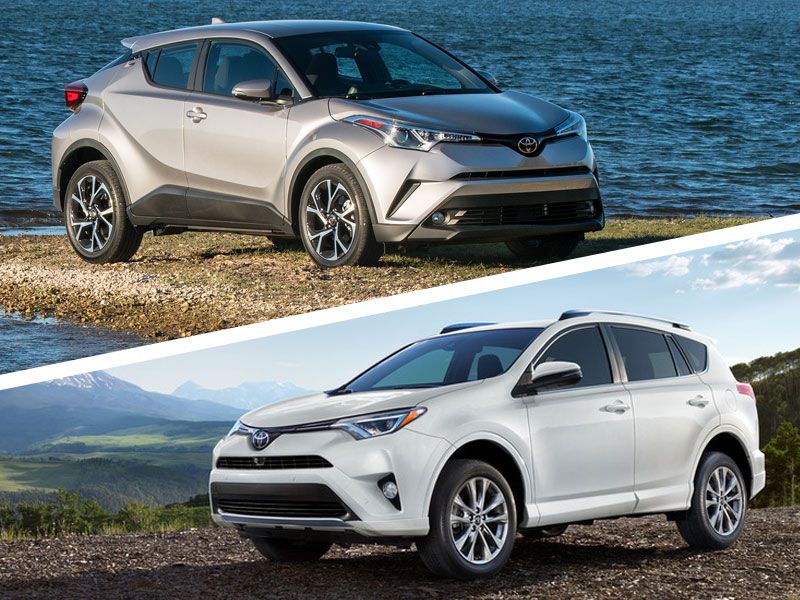
2018 Toyota C HR vs RAV4 exterior hero ・ Photo by Toyota
The popularity of compact crossovers means there are lots of choices, which can get confusing. Even deciding between two vehicles from the same car company can be a challenge. The Toyota RAV4 crossover has been around for years and is a popular choice for shoppers who want the perks of an SUV in a smaller package.
This year, the Toyota C-HR compact crossover joined the Toyota lineup as an even smaller alternative. These two vehicles are similar, but there are big differences between the two. Let’s take a closer look at the 2018 Toyota C-HR and 2018 Toyota RAV4 to see which is right for you.
Trim Levels
The RAV4 offers plenty of variety with six gas-powered trim levels and an additional four trims with a hybrid powertrain. While hybrid models offer only all-wheel-drive, there’s a choice of front- or all-wheel drive on every trim level equipped with the gas engine. This variety gives you plenty of room to pick a RAV4 equipped to your needs at a price within your budget.
The C-HR comes only in XLE and XLE Premium trim levels, so it simply doesn’t have the variety offered by the RAV4. Even the top trim, however, is priced below the base model of the RAV4 making it a good choice for those who put a priority on price.
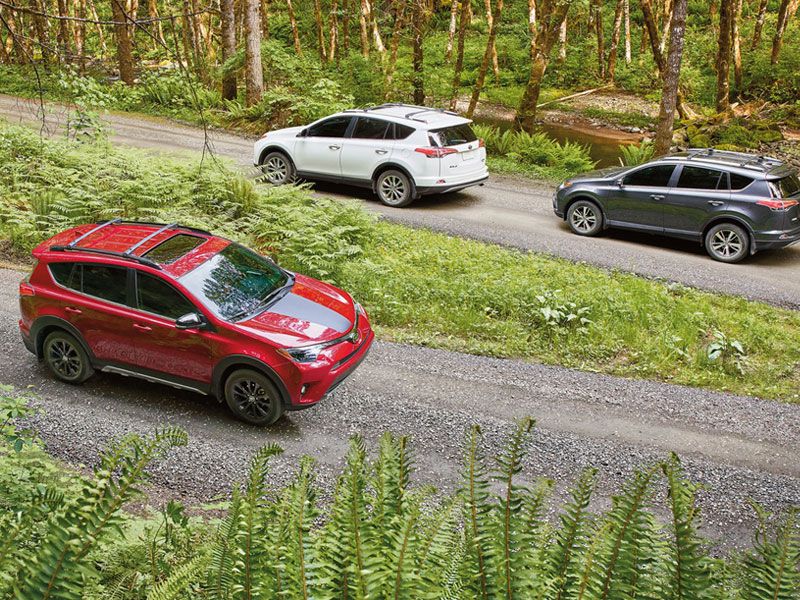
Photo by Toyota
Pricing
The Toyota RAV4 has a starting price of $24,510 for the base LE with front-wheel drive. All-wheel-drive takes the price up to $25,600. Sitting at the top of the lineup is the Platinum with all-wheel-drive and a starting price of $36,250. There are also four hybrid trims ranging from $27,235 to $34,130.
The Toyota C-HR has a lower starting price of $22,500 for the base XLE, while the top XLE Premium trim comes in at $24,350. Front-wheel drive is your only option and there are only these two trims. The price of entry is lower for the C-HR, but your choices are limited.
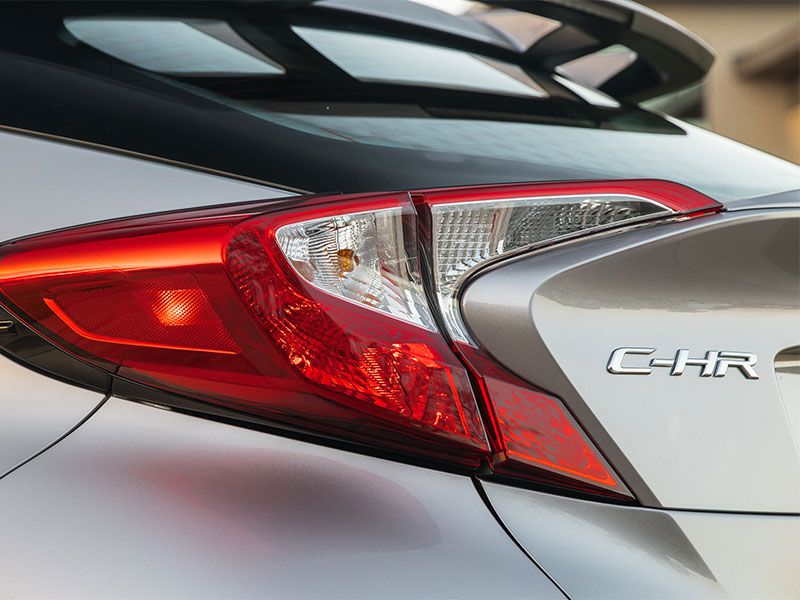
Photo by Toyota
Powertrain
The RAV4 is powered by a 2.5-liter 4-cylinder engine with 176 horsepower and 172 lb-ft of torque paired to a 6-speed automatic transmission, with a choice of front-wheel or all-wheel-drive. This gives the RAV4 plenty of power to merge onto the highway and provides a burst of speed for passing.
Power for the C-HR comes from a 2.0-liter 4-cylinder engine with 144 horsepower and 139 lb-ft of torque paired to a continuously variable automatic transmission offered only with front-wheel drive. Since this is a smaller vehicle, it can get by with less horsepower, but this is still a small engine. The C-HR has modest acceleration and takes its time to get up to highway speeds.
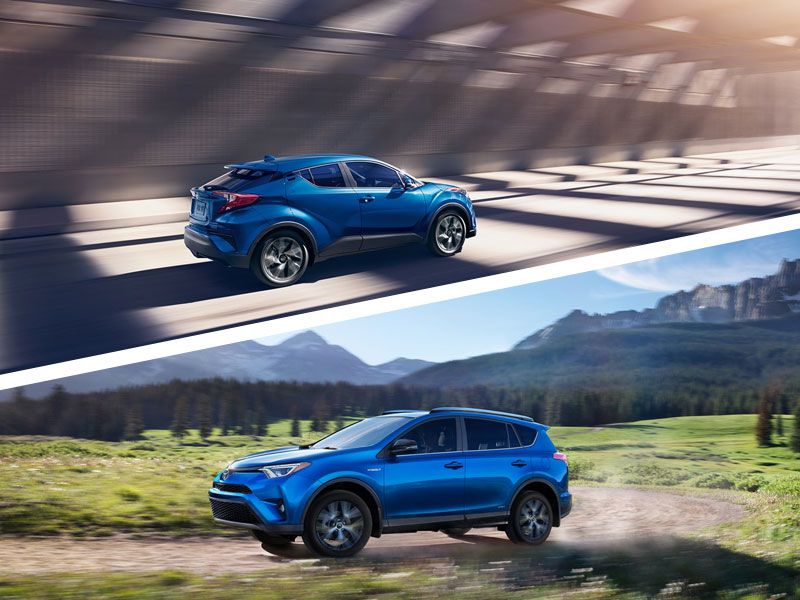
Photo by Toyota
Fuel Efficiency
The RAV4 has an EPA-estimated fuel economy of up to 23 mpg in the city, 30 mpg on the highway, and 26 mpg combined in front-wheel drive models. If you choose the all-wheel-drive option, those numbers drop to 22 mpg in the city, 28 mpg on the highway, and 25 mpg combined.
The smaller engine in the C-HR helps it achieve better fuel economy than the RAV4. It gets an EPA estimated 27 mpg in the city, 31 mpg on the highway, and 29 mpg combined. That’s a big difference that translates into big savings, especially for those with long commutes.
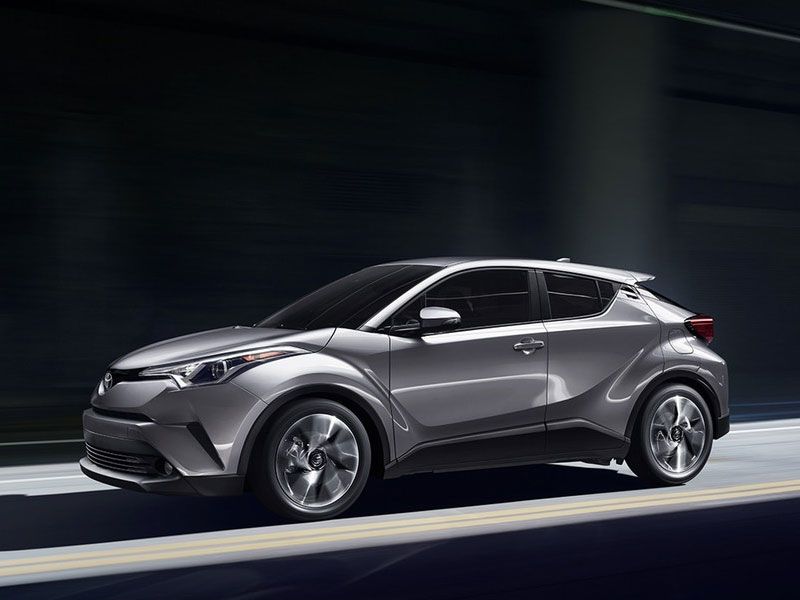
Photo by Toyota
Ride and Handling
The RAV4 has a smooth, comfortable ride with a quiet cabin. Engine noise is kept to a minimum even under hard acceleration, and both road and wind noise are well-muted. Handling is also good with somewhat relaxed steering that is easy on longer trips and still provides plenty of control.
The C-HR is a noisier ride, largely due to its continuously variable automatic transmission. It’s loud, especially when you accelerate hard, and makes sure you know the engine is working. The ride is smooth, but rough road surfaces and potholes will not go unnoticed. Road and wind noise are also more noticeable, although the C-HR’s smaller size means it’s still easy to carry on a conversation with rear seat passengers.

Photo by Toyota
Infotainment
The RAV4 offers several versions of Entune Audio with increasing features as you move up the trim lineup. The base system has a 6.1-inch touchscreen with AM/FM/CD/MP3 and 6-speakers. Higher trims have a seven-inch touchscreen and additional features including navigation, Siri Eyes Free, Sirius XM, and a premium JBL audio system with 11 speakers and a subwoofer. Apple CarPlay and Android Auto are not currently offered on Toyota products.
The C-HR doesn’t offer the same choices, in fact, there’s only one audio system available for both trim levels. It does have a seven-inch touchscreen standard, which is a plus. It also has AM/FM, Bluetooth connectivity, and HD Radio, but navigation is not available.
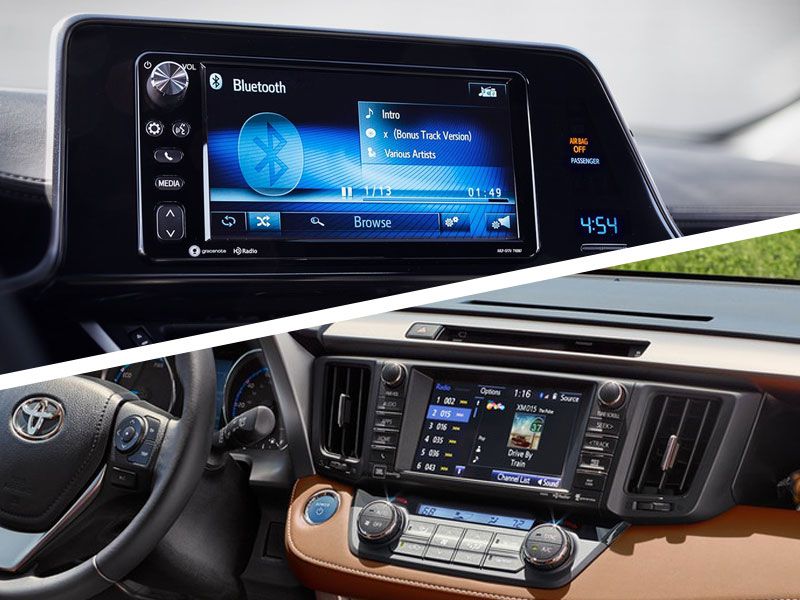
Photo by Toyota
Passenger Room
There’s room for five passengers in both the RAV4 and C-HR, but with varying amounts of space. The RAV4 has 39.8 inches of headroom up front and 38.9 inches in the rear, while the C-HR comes in lower with 38.1 inches for front passengers and 38.3 inches for passengers in the rear.
When it comes to legroom, the RAV4 offers 42.6 inches up front and 37.2 inches in the back. This time, the C-HR wins out if you happen to sit up front. It offers 43.5 inches for front passengers and 31.7 inches for rear passengers. The C-HR has more legroom for the driver, but a much smaller rear seat well-suited to kids.
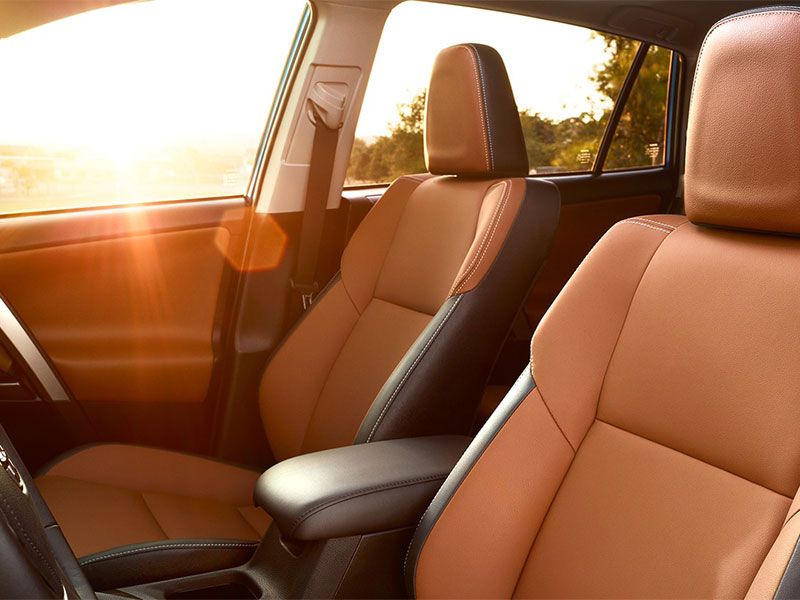
Photo by Toyota
Cargo
On the cargo front, the RAV4 comes out ahead simply because it’s a larger vehicle. There’s 38.4 cubic feet behind the first row and 73.4 cubic feet behind the first row. The RAV4 can also tow up to 3,500 pounds in select trims offering the flexibility to carry a full load of passengers and still transport cargo.
The numbers drop significantly for the C-HR. It has 19.0 cubic feet behind the first row and 36.4 cubic feet behind the second row but isn’t rated for towing. This makes the C-HR less flexible but if cargo isn’t a priority, then this still could be the better choice.

Photo by Toyota
Style
The RAV4 is due for an update, so styling this year isn’t particularly exciting. It doesn’t stand out from the growing crowd of crossovers. The one exception is the Adventure trim, which has a more rugged look with larger fender flares, black accents, and carbon-fiber-like interior trims. The RAV4’s extensive trim range also means there are interior options for a more upscale cabin.
The C-HR is a new model for 2018 and it has stand-out styling. It’s almost quirky with an edgy look that is both sporty and unique. It has a wide, curvy front end and tail lamps that protrude from the back making sure this compact crossover doesn’t simply blend in with the crowd.
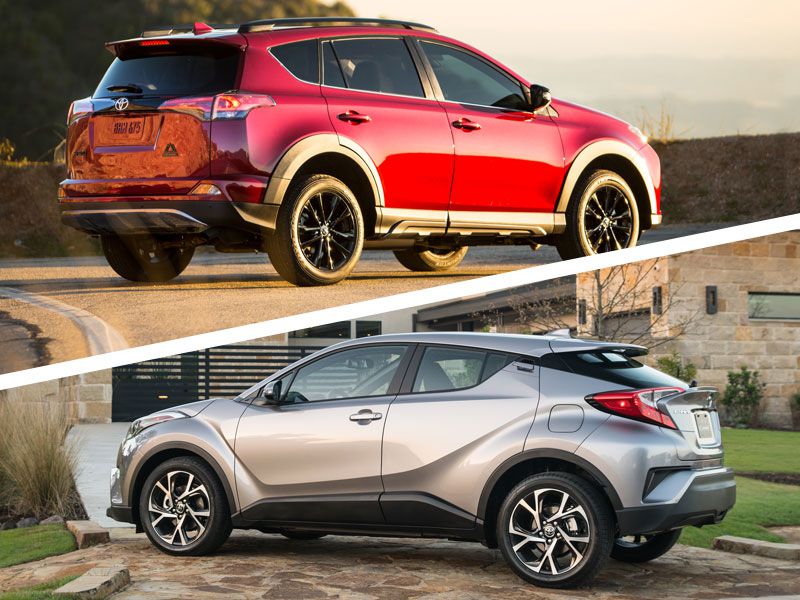
Photo by Toyota
Safety
The RAV4 is an Insurance Institute for Highway Safety (IIHS) 2018 Top Safety Pick. It received a top Good rating in all crash tests except for small front overlap passenger-side, which received a Poor rating. The RAV4 also received a Superior for front crash prevention technologies. The C-HR has not yet been crash tested, so there are no ratings for this model.
Both the RAV4 and C-HR come standard with Toyota Safety Sense P, which includes pre-collision with pedestrian detection, lane departure warning with steering assist, automatic high beams, and dynamic radar cruise control. They also feature the Star Safety System which includes stability control, traction control, anti-lock brakes, electronic brake-force distribution, brake assist, and Smart Stop Technology.
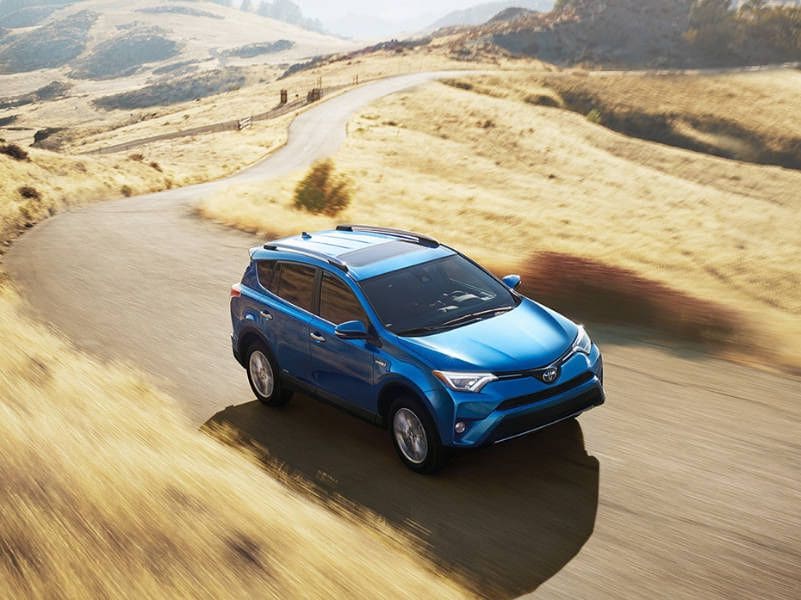
Photo by Toyota